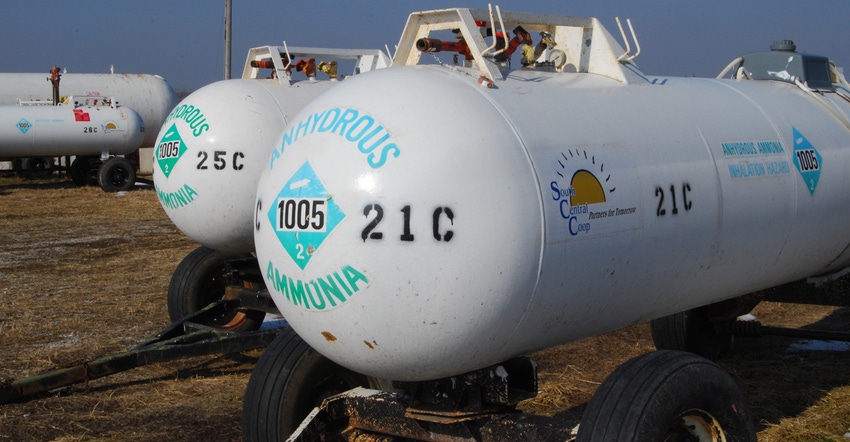December 24, 2018

Uncooperative weather that made harvest such a pain really put a damper on fieldwork through the rest of 2018. The number of discussions and questions stemming from the wet fall and the early snow has gone up as we get deeper into winter.
There may not be definitive answers to some of the questions, but the discussion is still worthwhile. Conversations and contingency planning with your local input suppliers now might take some of the pain out of what will likely be a wild spring season.
Should we be spreading dry fertilizer on bare frozen ground or over snow? Dry fertilizer applications went a little better than fall-applied anhydrous ammonia (NHɜ), but most areas are still behind, thanks to all the rain, snow and subsequent sloppy mud. Is catching up on dry applications in winter months a good idea if we can get back in the field?
Winter application decisions
Guidelines from ISU publications tell us the major considerations are having fertilizer in contact with the soil surface, moving the fertilizer into the soil, and not losing it through sheet erosion. Keep these tips in mind:
• Because most fertilizer materials are water-soluble, loss can occur in snowmelt runoff if the fertilizer does not come in contact with the soil surface.
• Fertilizer can be applied on fields that are level to nearly level, with or without snow cover. Some snowmelt runoff would be expected because fertilizer spread on snow must melt through the snow to contact the soil.
• Fertilizer can be spread on fields in winter with slopes not exceeding 5%, if crop residue, contour rows or other conservation practices are there to slow runoff.
• Fertilizer can be spread on a light snow cover if the fertilizer can melt through the snow.
• Do not spread fertilizer on fields in winter, when sheet erosion is likely to occur.
• Fields with predominant slopes greater than 5% should be carefully judged before winter application of fertilizer. Do not apply fertilizer in winter on such fields if runoff will be rapid, or if sheet erosion probably will occur.
Consider regulations
As I was looking for additional perspective on winter fertilizer application, I ran across an Ohio law pertaining to applications of granular fertilizer (defined as nitrogen or phosphorus). Ohio farmers may not apply:
• on snow-covered or frozen soil
• when top 2 inches of soil saturated from precipitation
• when local weather forecast has over a 50% chance of precipitation exceeding 1 inch in a 12-hour period for granular fertilizer or a half-inch in a 24-hour period for manure.
This Ohio wording for commercial fertilizer application has similarities to some of our Iowa manure regulations. It makes you wonder — in addition to being good application guidance — is this a look into our future regarding Iowa regulations on commercial fertilizer?
Hard to say, and all of that is a lot to digest for what seems like a simple question. Hopefully, this information will help all of us analyze and prioritize fields that might need fertilizer spread for the 2019 crop.
Are we crying wolf?
Large areas of the upper Midwest are in the same boat this winter as we are in across most of Iowa: Not much fall NHɜ was applied. Sure, wholesalers, retailers and the rest of us tend to get worked up every year that fall fertilizer application doesn’t go our way, and we talk about how tough it will be in the spring. Then most of the time there are some in-season hiccups. But when all the dust settles, it turns out things go fairly well, and the N gets applied.
So, have we been crying wolf all these years in saying tough fall application seasons mean trouble come spring? Maybe. But my perspective on this cycle is that it’s not crying wolf, but rather the concern and subsequent discussions helped lead to better planning and execution that eased the pain each spring.
With some folks in the fertilizer distribution network saying this was the worst fall application season they’ve ever seen, we are either very concerned or taking “crying wolf” to a new level. Either way, sitting down with your suppliers and making plans — and backups — may prevent both of you from getting “howling mad” this spring.
NH3 vs. urea vs. UAN
Let’s look at the logistics first. With not much product applied in fall, there will be a lot of pressure on the entire system this spring. Moving that volume of tonnage can run into all sorts of challenges at both ends of the spectrum. On the production and transportation end, storage and transport will be issues. And if those go better than expected, we still aren’t out of the woods.
If wholesalers can get enough NH3 to retailers this spring, will retailers have the capacity to keep up? Are there enough applicators and nurse tanks to keep everything going? And what if tough spring weather compresses our spring NH3 season?
The trend in wet springs where it’s hard to get NH3 on is for a shift toward using dry or liquid N. How easily can you change products with your retailer? Is there any penalty for locking in early or for waiting? If you need any of your nitrogen custom-applied, that’s another good topic to cover with your supplier.
And now for the other part of the equation: pricing. If you are planning on spring-applied NH3 and prepay for it, what happens if you want to switch some acres to dry or liquid? Do you get the same pricing and discounts that were available for dry and liquid at the time you paid for the NH3? If the fertilizer markets have moved up or down significantly, what happens with your prepay dollars if you switch? Is there a penalty for not taking any NH3 tons you had locked in?
These are a few of the issues that can occasionally create problems if everyone isn’t on the same page. Best bet is to cover this topic with your fertilizer dealer, along with your other questions.
McGrath is the on-farm research and Extension coordinator for the Iowa Soybean Research Center at ISU. Contact him at [email protected].
About the Author(s)
You May Also Like






